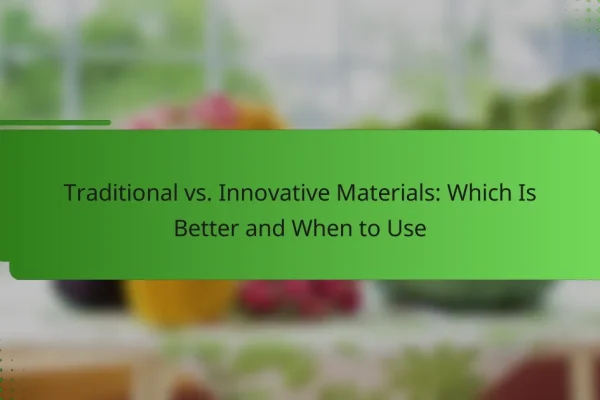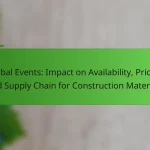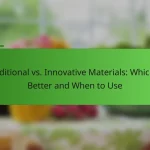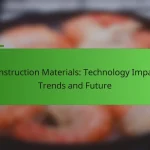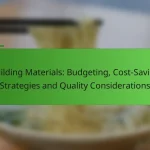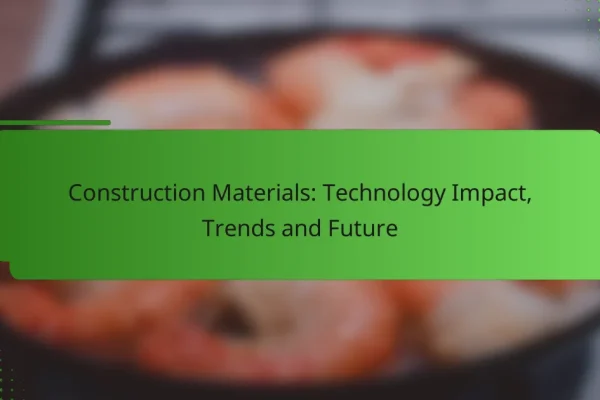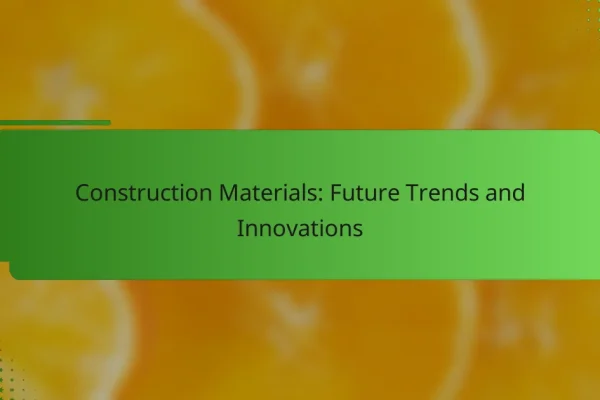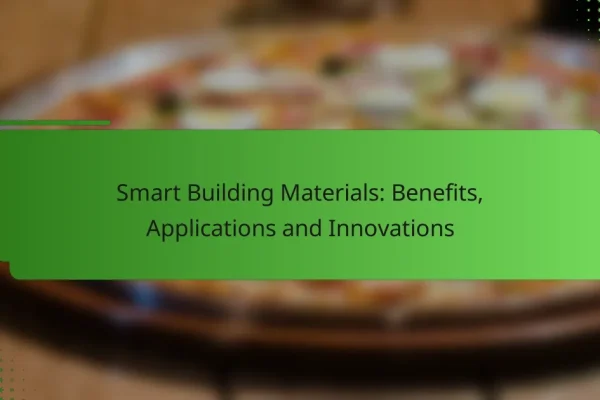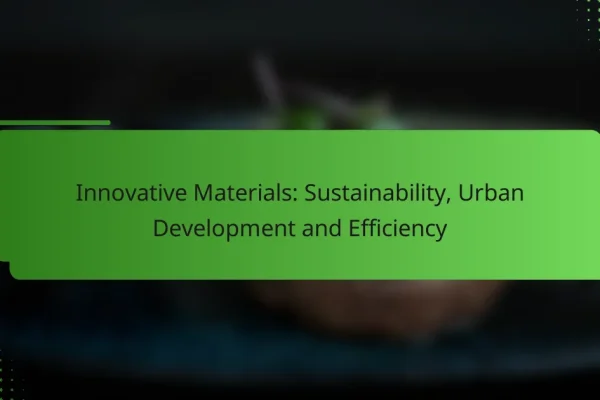What are the latest innovations in building supplies?
The latest innovations in building supplies focus on enhancing efficiency, sustainability, and functionality. Key developments include smart materials, eco-friendly options, modular construction techniques, and advancements in 3D printing.
Smart building materials
Smart building materials are designed to respond dynamically to environmental changes, improving energy efficiency and comfort. Examples include materials that can change their thermal properties based on temperature or humidity, enhancing insulation and reducing energy costs.
When selecting smart materials, consider their integration with existing systems and the potential for long-term savings. Look for products that meet industry standards for performance and durability.
Eco-friendly options
Eco-friendly building supplies prioritize sustainability and minimize environmental impact. These materials often include recycled content, low VOC emissions, and are sourced from renewable resources, such as bamboo or reclaimed wood.
To ensure you are choosing the best eco-friendly options, check for certifications like LEED or Energy Star. These labels indicate that the materials meet specific environmental performance criteria, helping you make informed decisions.
Modular construction techniques
Modular construction techniques involve prefabricating building sections off-site and assembling them on location. This method can significantly reduce construction time and waste, as well as improve quality control.
When considering modular construction, evaluate the design flexibility and local regulations regarding prefabricated structures. This approach can lead to cost savings and faster project completion, making it an attractive option for many builders.
3D printing applications
3D printing applications in building supplies allow for the rapid production of complex structures and components. This technology can reduce material waste and enable custom designs that traditional methods cannot achieve.
As you explore 3D printing for construction, consider the types of materials used, such as concrete or polymers, and their suitability for your project. Keep in mind that while initial costs may be higher, the long-term benefits can include reduced labor and material expenses.
How do these innovations improve construction efficiency?
Innovations in building supplies enhance construction efficiency by minimizing waste, accelerating project timelines, and reducing labor costs. These advancements streamline processes, allowing for more effective resource management and quicker completion of projects.
Reduced waste through precision
Precision in building supplies leads to significant waste reduction by ensuring materials are cut and used accurately. Technologies such as computer-aided design (CAD) and laser cutting allow for exact measurements, which minimizes excess material and disposal costs.
For example, using prefabricated components can reduce on-site waste by up to 30%, as these parts are manufactured to exact specifications. Implementing just-in-time delivery systems further decreases waste by aligning material arrival with project needs.
Faster project timelines
Innovative building supplies enable faster project timelines by simplifying construction processes and reducing delays. Modular construction techniques, where sections of a building are pre-assembled off-site, can cut project durations significantly, often by weeks or even months.
Additionally, advancements in materials, such as quick-setting concrete, allow for faster curing times, enabling subsequent work to begin sooner. This efficiency can lead to earlier project completions and quicker occupancy, which is crucial in competitive markets.
Lower labor costs
Lower labor costs result from innovations that require fewer workers or less time to complete tasks. Automation and robotics in construction can handle repetitive tasks, reducing the need for manual labor and allowing skilled workers to focus on more complex aspects of a project.
For instance, using advanced machinery for tasks like bricklaying can decrease labor requirements by up to 50%. Additionally, training workers on new technologies can enhance productivity, leading to overall cost savings in labor expenses.
What are the benefits of using eco-friendly building supplies?
Using eco-friendly building supplies offers numerous advantages, including reduced environmental impact and enhanced sustainability. These materials often lead to better energy efficiency and healthier living spaces, making them a wise choice for both builders and homeowners.
Improved energy efficiency
Eco-friendly building supplies typically include materials that enhance a structure’s energy efficiency. Insulation made from recycled or natural fibers can significantly reduce heating and cooling costs, often leading to savings of 20-30% on energy bills.
Additionally, using energy-efficient windows and doors can minimize heat loss and gain, further improving overall energy performance. Consider investing in materials that meet ENERGY STAR standards for optimal results.
Healthier indoor environments
Eco-friendly materials contribute to healthier indoor environments by reducing exposure to harmful chemicals and pollutants. Many traditional building supplies release volatile organic compounds (VOCs), which can affect air quality and health.
Opting for low-VOC paints, finishes, and adhesives can create a safer living space. Natural materials like bamboo or reclaimed wood not only reduce toxins but also enhance aesthetics and comfort.
Regulatory compliance advantages
Using eco-friendly building supplies can help builders comply with local and national regulations aimed at promoting sustainability. Many jurisdictions offer incentives or rebates for projects that meet green building standards, such as LEED certification.
Staying informed about local building codes and sustainability initiatives can provide financial benefits and improve project viability. Check for specific guidelines in your area to ensure compliance and maximize potential savings.
Which companies are leading in building supplies innovation?
Several companies are at the forefront of innovation in building supplies, focusing on advanced materials and sustainable practices. GAF, DuPont, and Hempitecture are notable leaders, each contributing unique solutions to the construction industry.
GAF for roofing solutions
GAF is a prominent player in roofing solutions, known for its innovative products that enhance durability and energy efficiency. Their roofing systems often incorporate advanced materials that improve weather resistance and reduce energy costs.
When selecting GAF products, consider options like their Timberline® shingles, which offer a blend of aesthetics and performance. Homeowners can expect warranties ranging from 25 years to a lifetime, depending on the product line.
DuPont for insulation materials
DuPont leads in insulation materials, providing solutions that optimize energy efficiency in buildings. Their products, such as Tyvek® and Styrofoam™, are designed to improve thermal performance while being environmentally friendly.
For effective insulation, evaluate the R-value of DuPont materials, which indicates their resistance to heat flow. Higher R-values generally mean better insulation, with common residential values ranging from R-13 to R-60, depending on the climate zone.
Hempitecture for sustainable materials
Hempitecture specializes in sustainable building materials, particularly those derived from hemp. Their products, including hempcrete and insulation, are eco-friendly alternatives that contribute to reduced carbon footprints in construction.
Using Hempitecture’s materials can help builders meet green building standards, such as LEED certification. Additionally, hemp-based products often provide excellent thermal and acoustic insulation, making them a practical choice for environmentally conscious projects.
What factors should you consider when selecting innovative building supplies?
When selecting innovative building supplies, consider compatibility with existing structures, cost-effectiveness, and sustainability. These factors will help ensure that the materials not only fit your project needs but also provide long-term value.
Compatibility with existing structures
Ensuring that new building supplies are compatible with existing structures is crucial for structural integrity and functionality. This involves checking material properties, load-bearing capacities, and architectural styles. For example, if you are retrofitting a historic building, you may need materials that match the original construction methods and aesthetics.
To assess compatibility, conduct thorough inspections and consult with structural engineers. They can provide insights into how new materials will interact with older ones, helping you avoid costly modifications later.
Cost-effectiveness
Cost-effectiveness is a key consideration when choosing innovative building supplies. Evaluate not only the initial purchase price but also the long-term savings on maintenance, energy efficiency, and durability. For instance, while high-performance insulation may have a higher upfront cost, it can significantly reduce heating and cooling expenses over time.
To determine cost-effectiveness, create a budget that includes all potential expenses and savings. Consider using a simple cost-benefit analysis to compare different materials and their lifecycle costs. This approach will help you make informed decisions that align with your financial goals.
